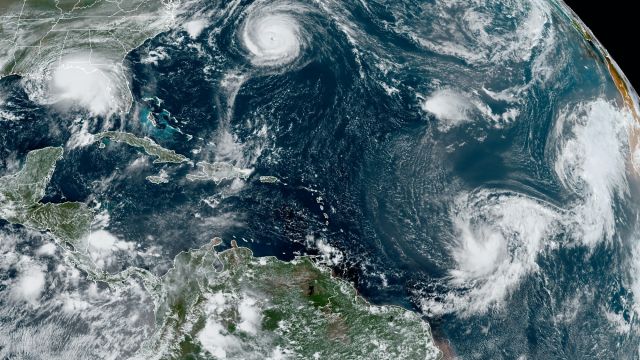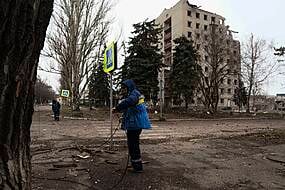With Sally bringing rapidly strengthening winds of at least 100mph and heavy rain, forecasters have warned of “potentially historic” flooding.
The slow-moving storm was forecast to brush the south-eastern tip of Louisiana and then blow ashore late on Tuesday or early Wednesday near the Mississippi-Alabama border, the National Hurricane Centre said.
Hurricane warnings stretched from Morgan City, Louisiana, to Navarre, Florida – a stretch of more than 300 miles.
A Hurricane Katrina monument is surrounded by rising water in eastern St Bernard Parish, Louisiana, as residents evacuate for Hurricane Sally (Chris Granger/The Advocate/AP)
President Donald Trump issued an emergency declaration for parts of Louisiana and Mississippi on Monday, an action that authorises federal emergency officials to coordinate disaster relief efforts and provide emergency assistance to the affected areas.
Alabama governor Kay Ivey asked the president to do the same for her state after the National Weather Service in the city of Mobile warned of the increasing likelihood of “dangerous and potentially historic flooding”.
The weather service forecast waters could rise as much as nine feet above ground in large parts of the Mobile metro area. With a population of 400,000 people, it is among the largest metro areas along the Gulf Coast between New Orleans and Tampa, Florida.
Some businesses in Mobile placed sandbags at their entrances in preparation.
Florida governor Ron DeSantis declared a state of emergency in the Panhandle’s westernmost counties as the hurricane’s outer bands began to lash the area.
Storm surge floods a parking lot in Pensacola Beach, Florida (Tony Giberson/Pensacola News Journal/AP)
Along the storm-weary Gulf Coast, residents rushed to buy bottled water and other supplies ahead of the hurricane, which powered up to Category 2 in the afternoon.
Forecasters said sustained winds could reach 110mph, just less than Category 3 strength, by landfall.
Seawater and sand swept onto roads on one end of Dauphin Island off the coast of Alabama, washing away several cars, Dauphin Island Mayor Jeff Collier said. He said around a dozen people had to be evacuated.
In coastal Mississippi, water spilled onto roads, lawns and docks well before the storm’s arrival. All of the area’s 12 casinos were ordered to shut down on Monday afternoon and governor Tate Reeves urged residents of low-lying areas to prepare to evacuate.
“This is the real deal, and it deserves your attention,” Mr Reeves wrote on Twitter. “Be smart. Prepare for worst. Pray for the best,” he said.
Hurricane Sally is headed straight for Mississippi and it is now a Category 2. Make plans to evacuate low-lying areas. Emergency operators are ready to respond. This is the real deal, and it deserves your attention.
Be smart. Prepare for worst. Pray for the best.— Governor Tate Reeves (@tatereeves) September 14, 2020
Reeves said Sally could dump up to 20 inches of rain on the southern part of the state. Shelters opened, but officials urged people who are evacuating to stay with friends or relatives or in hotels, if possible, because of the coronavirus.
The town of Kiln, Mississippi, where many homes sit high on stilts along the Jourdan River and its tributaries, was under a mandatory evacuation order, and it appeared most residents obeyed.
For only the second time on record, forecasters said, five tropical cyclones swirled simultaneously in the Atlantic basin at one point on Monday. The last time that happened was in 1971.
In addition to Sally were Hurricane Paulette, which passed over a well-fortified Bermuda on Monday and was expected to peel harmlessly out into the North Atlantic; and Tropical Storms Rene, Teddy and Vicky, all of them out at sea and unlikely to threaten land this week, if at all. Rene was downgraded to a trough of low pressure Monday evening.
Sally was about 135 miles (217 kilometers) south of Biloxi, Mississippi, on Monday night, moving at 6 mph (9 kph). The hurricane’s sluggish pace could give it more time to drench the Mississippi Delta with rain and storm surges.
#Sally is expected to move slowly over the next several days. Life-threatening flash flooding and river flooding is likely over portions of the central Gulf Coast from the western Florida panhandle to southeastern Louisiana. @NWSWPC forecasts 8-16” of rain, isolated areas to 24”. pic.twitter.com/PBpW2ja1E1
— National Hurricane Center (@NHC_Atlantic) September 14, 2020
Sally was moving west-northwest Monday night but forecasters expected it to turn slightly east.
The extraordinarily busy hurricane season — like the catastrophic wildfire season on the West Coast — has focused attention on the role of climate change.
Scientists say global warming is making the strongest of hurricanes, those with wind speeds of 110 mph or more, even stronger. Also, warmer air holds more moisture, making storms rainier, and rising seas from global warming make storm surges higher and more damaging.
In addition, scientists have been seeing tropical storms and hurricanes slow down once they hit the United States by about 17% since 1900, and that gives them the opportunity to unload more rain over one place, as 2017’s Hurricane Harvey did in Houston.







